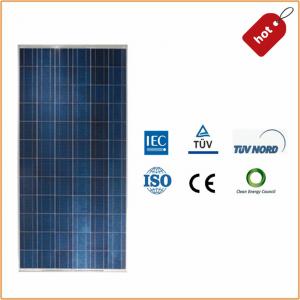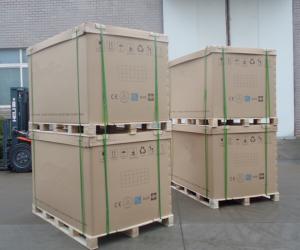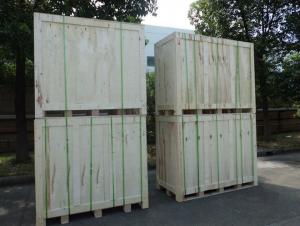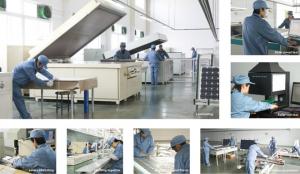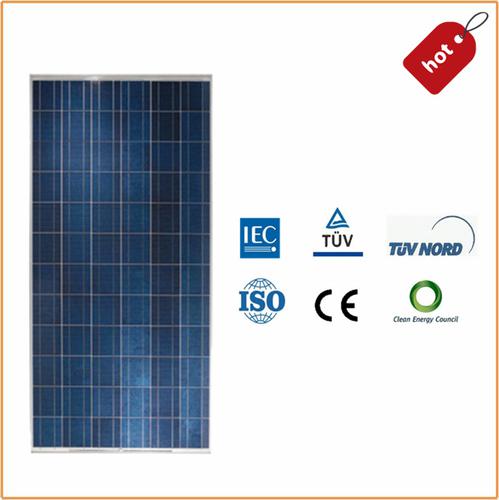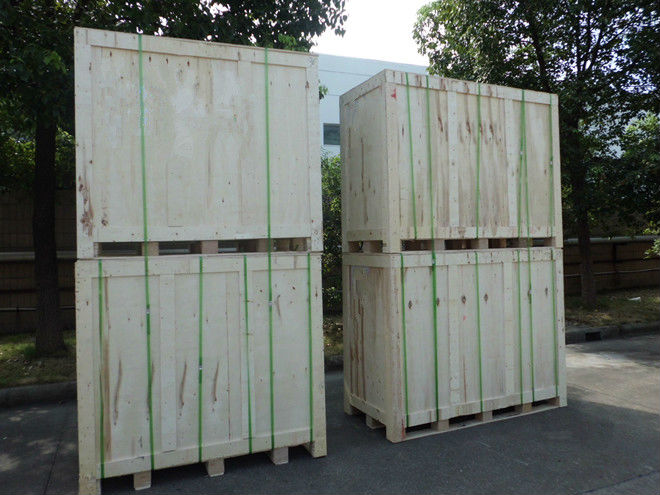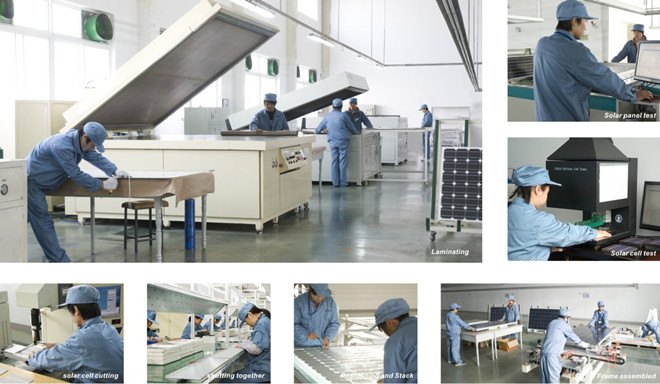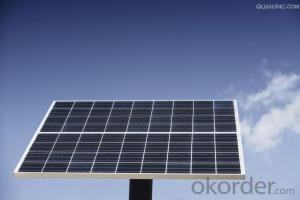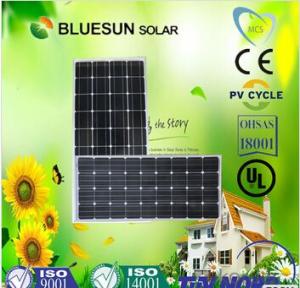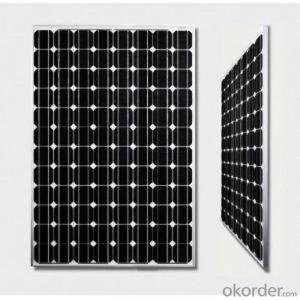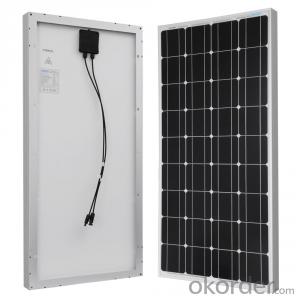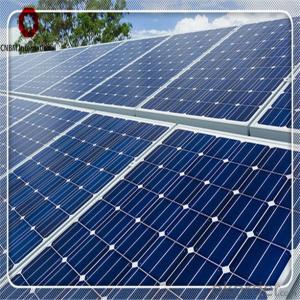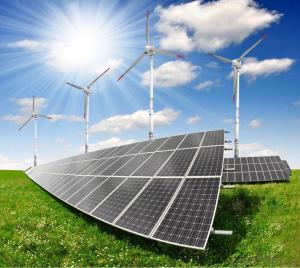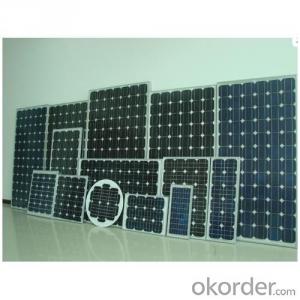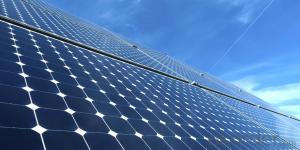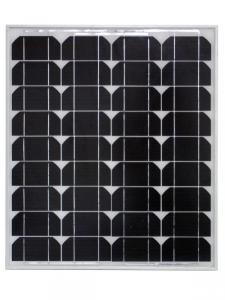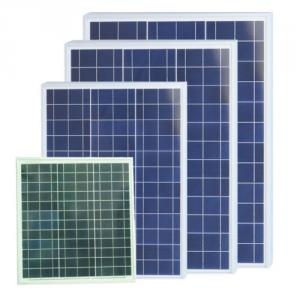Solar Panels Vermont 310W from China Manufacturers
- Loading Port:
- Ningbo
- Payment Terms:
- TT or LC
- Min Order Qty:
- -
- Supply Capability:
- 600MW watt/month
OKorder Service Pledge
OKorder Financial Service
You Might Also Like
Competitive Prices 310w Poly Solar Panels
Solar Panel 300w with Good Quality and Warranty
Mechanical Characteristics
Cell Type | Poly Crystalline 156×156mm(6 inch) |
No. of Cells | 72(6×12) |
Dimension | 1950×992×50mm |
Weight | 23kg |
Component element
Front Glass | 3.2mm, High Transmission, Low Iron, Tempered Glass |
Frame | Anodized Aluminum Alloy Type 6063-T5 |
Junction Box | IP 65 Rated (Black) |
Output Cables | TUV 1×4mm2, length:900mm |
Connector | MC4(UV resistance and self-locking/IP67) |
Encapsulation Material | EVA(0.50±0.03mm thickness) |
Back Foil | White TPT(0.32±0.03mm thickness) |
Fixing Adhesive | Silicone Sealant(White) |
Specifications
Module Type | NBJ-270P | NBJ-280P | NBJ-290P | NBJ-300P |
Maximum Power at STC (Pmax) | 270Wp | 280Wp | 290Wp | 300Wp |
Maximum Power Voltage (Vmp) | 36.21V | 36.38V | 36.50V | 36.60V |
Maximum Power Current (Imp) | 7.46A | 7.61A | 7.95A | 8.20A |
Open-circuit Voltage (Voc) | 43.50V | 43.70V | 43.95V | 44.30V |
Short-circuit Current (Isc) | 7.98A | 8.24A | 8.50A | 8.77A |
Cell Efficiency (%) | 15.7% | 16.3% | 16.9% | 17.2% |
Module Efficiency (%) | 14% | 14.5% | 15.0% | 15.5% |
Operating Temperature( °C ) | -40°C ~+90°C | |||
Maximum System Voltage(V) | DC 1000V(TUV) / DC600V(UL) | |||
Maximum Rated Current Series(A) | 15A | |||
Power Tolerance | 0~+3% | |||
Temperature Coefficients of Pmax | (-0.45±0.05)%/°C | |||
Temperature Coefficients of Voc | (0.05±0.01) %/°C | |||
Temperature Coefficients of Isc | (-0.35±0.02)%/°C | |||
NOTC(°C ) | (47±2)°C | |||
STC: Irradiance 1000W/M2 Module Temperature: 25°C AM=1.5
Warranty
Warranty | 10-year warranty on product material and processing technology |
Industry power output warranty: 90% in 12 years, 80% in 25 years |
Packing Configuration
Q’ty/Pallet, | 1×20’ft | 1×40’GP | 1×40’HQ |
Pallet Q’ty | 5pallets | 11pallets | 11pallets |
Q’ty/Container | 200pcs | 440pcs | 495pcs |
Package
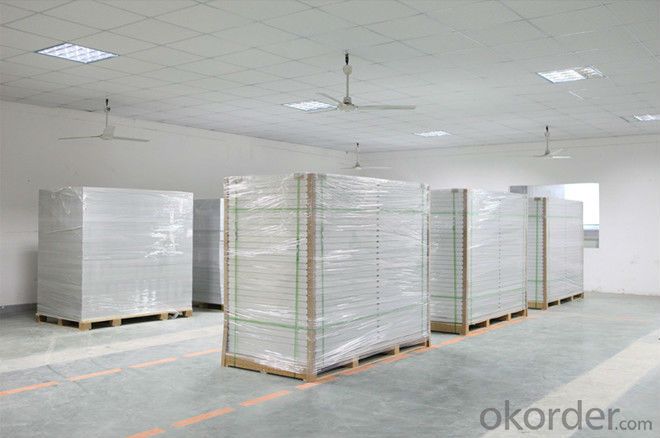
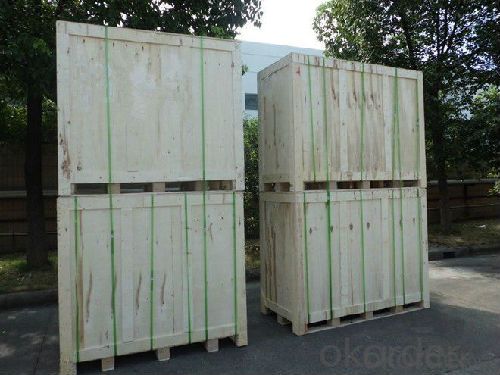
FAQ
I. Will you focus on the safety of the goods during transportation?
Yes, Safety of the cargo is the primary element that we would consider on transportation.
II..How would guarantee the quality will meet the requirements of your clients?
Before shipment, we will have inspection for each batch of goods.
III..What certificates do you have?
IEC,UL,TUV,CSA,etc.
IV..Can you do OEM according to clients’ requirements?
Yes, we have our own brand while we can provide OEM service.
- Q: I have a cabin that is way out in the middle of no where, it would cost 000's of dollars to get power to it. If I have a 8,000 BTU air conditioner that runs on 25 volts and 5 amps (or 875 watts)How many solar panels will I need to run this during the day, plus charge the batteries to run it all night? How many batteries would I need
- OK, in addition to the solar panels, you wil need an inverter (DC to AC; 2V t0 20V) capable of delivering 20A continuously and as much as 40A for the compressor starting surge, and a fairly large battery bank capable of delivering something over 2000 watts continuously (losses in the charging and conversion process) as well as the surge. So, if your actual demand is now calculated around 2000 watt/hour, and you need to both run the unit and charge batteries during the daylight hours - and considering that the ideal charging rate for a lead-acid battery is on the order of 0% of its capacity, you will need a huge reserve on the battery section and a huge excess on the solar section to make up for the 5 hours maximum input. So, the average high-quality deep-discharge battery will do about 400Ah @ 2.6V. Which comes to 5040 watts for one hour. For round figures, it will give you 2000 watts for 2.5 hours. You will need a minimum of eight of them just to make your system run for the 9 hours you are anticipating. Given that you do not want to run the batteries to zero each night, a 50% reserve would be a wise investment - comes to now twelve (2) batteries. Now, you will have to make 2000 watts (to run the unit) and also produce and another 8600 (per hour for five hours) watts to charge the batteries for the next night. Again, for round figures, you will need 0,000 watts of solar power, or seventy (70) panels. At ~0 watts/s.f. (00 watts/meter), that comes to about 000 square feet or 00 square meters. Modern non-crystaline panels may reduce this by 20%, or so but no more than that. You will be charging the batteries at roughly 20% of their discharge capacity - which will pretty much cut their service live in half, or so. As the average deep-discharge battery has about an 8-year life span under ideal conditions (and your situation will be far from ideal) you may expect to replace them every four years or so with good care. Much less with no care.
- Q: i was looking into making solar panels to reduce my electric bill, but i need to know how to actually hook it up.
- most of the listings are there to get you to send 'em money. some promise a refund if they don't work. good luck getting your money back. it's not going to happen. last, the inverter, and control to feed power back into the grid are expensive. the utility gets to control what you can use, and most often you have to buy it from them. in Calif, the utility has an interest in good solar installations. they provide power during the time of peak demand, so the utility does not have to build/buy the last, most expensive kilowatt. however, (A) any installation that will be at all useful is large, and expensive, and (B) as with all electronics, next year will be better. i'll probably do it. but not yet.
- Q: The first panel is located in New England, the second is placed in the Sahara desert, the third is on the Earth side of the moon, and the last is on the far side of the moon. Which panel would absorb the most sunlight over a year's time and why ? All the panels are place in optimal places where they would get the most light available.
- Best to worst- ) The Earth side of the Moon 2) Sahara Desert 3) New England 4) Far side of the Moon
- Q: I have to get a lot of information on how solar panels are developed and distributed in America because I have to do two pages on this. Please help me get information in this I really need it!! Thankss...
- The first link below is one of the best sites for recent news about solar panels. You should be able to find stories about solar panels under development today. A little bit of the history: Solar panels have been around for about 50 years now. They were first used to power spacecraft. Solar power for domestic use started to develop rapidly in the 970's during the first oil crisis, but as energy prices fell in the 980's solar development slowed. Most of the large solar panel makers were purchased by large oil companies who seemed not to be too interested in solar. In the late 990's as concerns about both Peak Oil and Global Warming grew there was renewed interest in solar power and a number of new companies were started to develop new kinds of solar panels. Many of these new companies have grown larger than the older solar companies still owned by big oil companies. Over the last 7 years or so growth in the solar market has been explosive with a compound growth rate of almost 40% per year. In 2005 the solar industry for the first time started to consume more silicon than all other electronic industries combined resulting in a world wide silicon shortage that is still with use. New silicon refineries are coming on line and the shortage is expected to diminish by 2008 or 2009. Check out the two links below. They will help you a lot.
- Q: Hi! I bought a Coleman 2 vdc cooler that pulls 9 amps. What size solar panel and amp-hour battery do I need? I only open it 3 times a day. It will hold about 3 gals of milk.
- If it pulls 9 amps continuously, that's 08 watts/hour or about 2.5 kwh/day. If it only pulls half that (does it cycle?) it's about .2 kwh/day. You only want to drain a lead-acid battery 50% or so, so you'll want a 5 or 2.5 kwh battery pack. A typical setup for the 5 kwh would be two L-6 batteries in series, and for the 2.5 kwh you could use 2 T-05 batteries in series. This does not account for days of cloud. If you regularly have cloudy days, size the battery pack for two or three days of use with no input (2-3 x the sizes given above). To charge them, you typically want panels that will charge your battery at least 5% of its capacity per hour (C/20). For 2 volt nominal panels that's 0 amps for the T-05 or 20 amps for the L-6 batteries. It's good to have more than that for battery life (it cuts down on what's called stratification), so you'll want probably 50-200 watts of panels for the T-05 and 300-400 for the L-6. You'll also need a charge controller. Peltier coolers are very inefficient. You'll save money by using a regular mini-fridge and an inverter. Most mini-fridges only draw 50 watts or so, so you're talking 600 watt-hours for a 50% duty cycle. This means two T-05 batteries will give you two days of use and you'll only need 20-50 watts of panel. DK
- Q: What is the impact of roof material on solar panels' performance?
- The choice of roof material can have a significant impact on the performance of solar panels. Certain materials, such as metal or asphalt shingles, are more conducive to efficient solar panel installation and operation. These materials provide a stable and sturdy base for mounting the panels, ensuring proper alignment and minimizing the risk of damage. Additionally, the reflectivity and heat absorption properties of the roof material can affect the overall efficiency of solar panels. Light-colored or reflective roofs can help reduce heat absorption, keeping the panels cooler and improving their performance. On the other hand, darker or less reflective roofs may lead to increased heat buildup, potentially reducing the efficiency of the panels. Ultimately, selecting a suitable roof material is crucial in maximizing the effectiveness of solar panels and optimizing their energy generation capabilities.
- Q: What would these solar panels power? For instance, my energy bill shows 2035kWh for last month. How much would this remove from that if it outputted full power? Thanks!
- These panels are for small remote applications. Traffic signs, motion sensor lights, etc, where it would cost more to run an electrical line than it does to buy the panel.
- Q: am having a 75 watts siemens solar panel and is giving me 2.89volts during bright light, i wanted to know can this be used to charge 00Am/hr battery?
- Many of the panels used on homes are designed to produce 2 volts DC. 0 of them wired in a series would produce 20 volts DC. An inverter is used to change the DC voltage to AC. The other aspect of electricity is amperage. With electrical units wired in series the voltage is added. When they are wired in parallel the amperage is added. The Volts x Amps produced will give you the wattage. A wise homeowner will examine their electric bills or the equipment used to determine their demand. They will consult tables that let them know how much sunlight their area receives each year as this will alter the rated performance of the panels. Then they will try and determine how much of the demand they want to fill. 80% may be economical. Then they also want to determine what they will do with excess electricity that may be produced during the summer months of intense sun and how they will supply the shortfall of low sun winter months. From all this they will determine the number of solar panels they need to purchase.
- Q: I need a list of worldwide solar panel manufactures from china, US, Spain, Germany, Japan etc...Can any one direct ne to such place?I rather it will also contain comparison of parameters like efficiacy, quality etc and to be divedied by country of manufacturing.Thank you
- You can't buy at that level unless you are connected to governement. A lot of production is already spoken for for years to come. Where you live determines what you can legally buy and install. The EU has it's own certification, the US has 2 sets, the Canadians have their own. Your answer also requires knowing the use for the solar panels, whether it is grid-tie, off-grid or standalone to power an appliance. And you have to choose mono crystalline, poly crystalline, or thin-film.
- Q: That one costs money but looks like it might work. I don't really have the money for it but if it works then it would probably be worth it. Do homemade solar panels really work or is it just a gimmick? I'm really interested to see if anyone has actually tried this and to see what they say about it.Thanks
- Yes there are plans and testimonials all over the internet and dozens of vids on youtube for homemade panels
Send your message to us
Solar Panels Vermont 310W from China Manufacturers
- Loading Port:
- Ningbo
- Payment Terms:
- TT or LC
- Min Order Qty:
- -
- Supply Capability:
- 600MW watt/month
OKorder Service Pledge
OKorder Financial Service
Similar products
Hot products
Hot Searches
Related keywords
